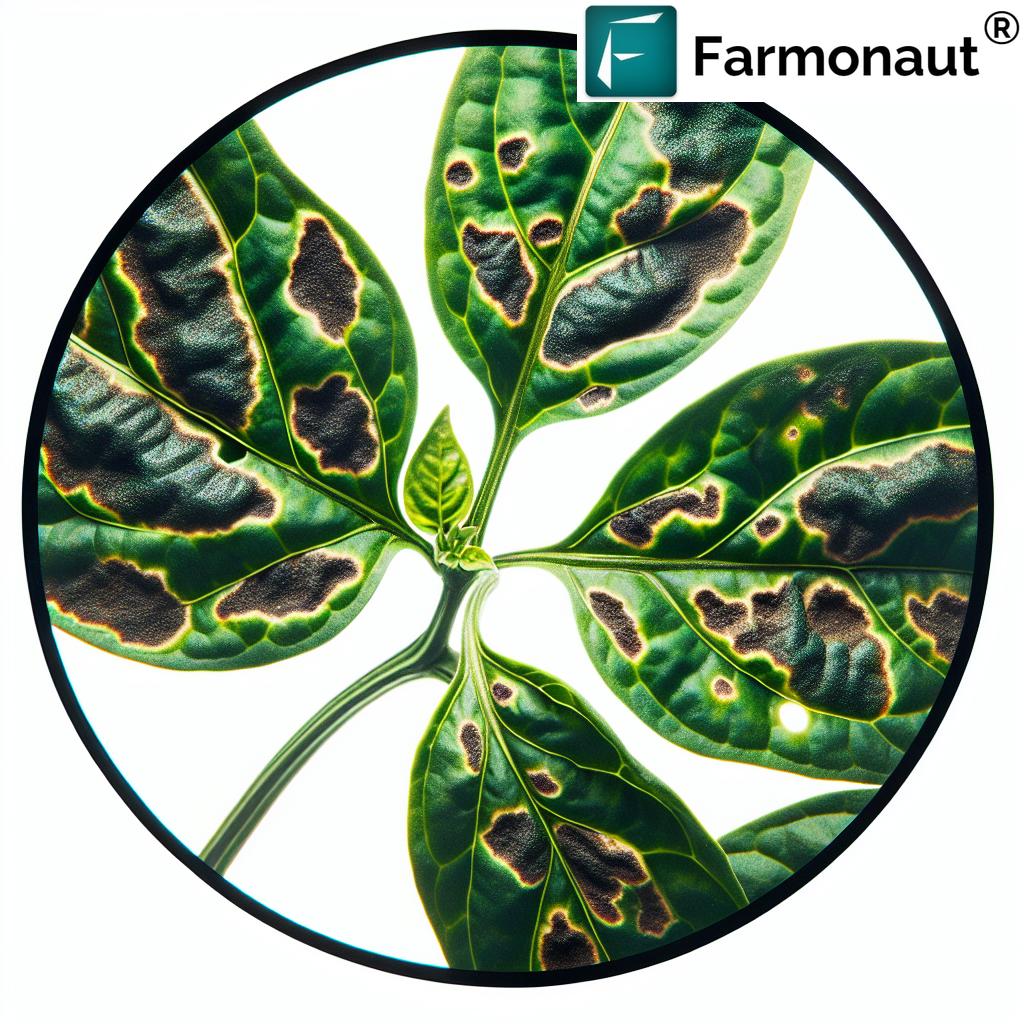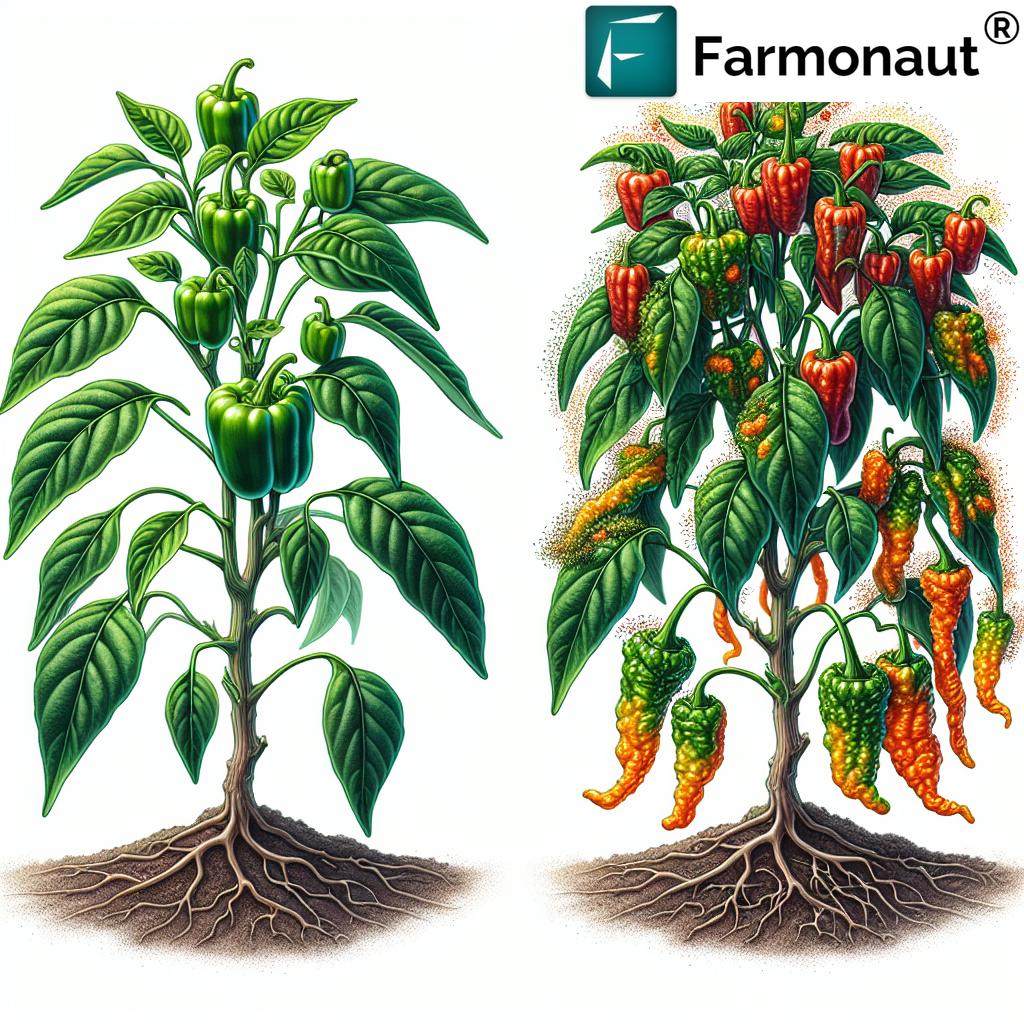Organic Anthracnose Treatment: Effective Control Measures for Pepper Plants and Other Species

At Farmonaut, we understand the challenges that farmers face when dealing with plant diseases like anthracnose. This devastating fungal infection can wreak havoc on various crops, particularly pepper plants. In this comprehensive guide, we’ll explore organic and conventional methods for controlling anthracnose, with a focus on environmentally friendly approaches that protect both your crops and the ecosystem.
Understanding Anthracnose: A Threat to Plant Health
Anthracnose is a destructive fungal disease that affects a wide range of plant species, including peppers, tomatoes, and various fruit trees. Caused by fungi in the Colletotrichum genus, this disease can lead to significant crop losses if left unchecked. As agricultural technology experts, we at Farmonaut are committed to helping farmers identify and combat this threat effectively.
The Science Behind Anthracnose
To better understand anthracnose, it’s essential to delve into its scientific background:
- Causal Agent: Fungi belonging to the Colletotrichum genus
- Host Range: Wide variety of plants, including peppers, tomatoes, and fruit trees
- Favorable Conditions: High humidity and warm temperatures
- Infection Process: Spores germinate on plant surfaces and penetrate tissues
Recognizing Anthracnose Symptoms
Early detection is crucial for effective anthracnose control. Here are the key symptoms to watch for in your pepper plants and other susceptible crops:
- Dark, sunken lesions on fruits, leaves, and stems
- Circular or angular spots on leaves, often with yellow halos
- Wilting and dieback of infected plant parts
- Premature fruit drop in severe cases

Organic Anthracnose Treatment Strategies
At Farmonaut, we prioritize sustainable farming practices. Here are some effective organic methods for controlling anthracnose in your pepper plants and other crops:
1. Cultural Control Measures
- Crop Rotation: Implement a 2-3 year rotation with non-susceptible crops
- Proper Spacing: Ensure adequate air circulation between plants
- Irrigation Management: Avoid overhead watering to reduce leaf wetness
- Sanitation: Remove and destroy infected plant debris
2. Organic Fungicides
While we emphasize non-chemical approaches, some organic fungicides can be effective against anthracnose:
- Copper-based fungicides (use sparingly to avoid soil accumulation)
- Neem oil
- Potassium bicarbonate
- Bacillus subtilis-based products
3. Biological Control Agents
Beneficial microorganisms can help suppress anthracnose-causing fungi:
- Trichoderma species
- Bacillus species
- Pseudomonas fluorescens
4. Plant-Based Treatments
Some plant extracts have shown promise in controlling anthracnose:
- Garlic extract
- Cinnamon oil
- Clove oil
- Lemongrass oil
Conventional Anthracnose Control Methods
While our focus is on organic approaches, we recognize that some farmers may need to consider conventional methods in severe cases:
Chemical Fungicides
Use these judiciously and always follow label instructions:
- Azoxystrobin
- Chlorothalonil
- Mancozeb
- Propiconazole
Note: Always consult local agricultural authorities for approved fungicides in your region.
Integrated Pest and Disease Management (IPM) for Anthracnose
At Farmonaut, we advocate for an integrated approach to managing anthracnose and other plant diseases. This strategy combines various control methods to achieve optimal results while minimizing environmental impact:
- Prevention: Implement cultural practices to create unfavorable conditions for disease development
- Monitoring: Regularly inspect plants for early signs of infection
- Threshold-based Action: Apply treatments only when disease levels reach economic thresholds
- Multiple Control Methods: Combine cultural, biological, and chemical (if necessary) approaches
- Evaluation: Assess the effectiveness of control measures and adjust strategies as needed
Leveraging Technology for Anthracnose Management
At Farmonaut, we harness the power of satellite technology and artificial intelligence to revolutionize crop disease management, including anthracnose control. Our advanced system offers several advantages over traditional detection methods:
| Aspect | Traditional Anthracnose Detection Methods | Farmonaut Satellite System Detection |
|---|---|---|
| Speed | Slow, relies on manual field inspections | Rapid, covers large areas in minutes |
| Accuracy | Variable, depends on inspector’s expertise | High, uses AI-powered image analysis |
| Cost-effectiveness | Labor-intensive and time-consuming | Efficient, reduces need for frequent field visits |
| Early Detection Capabilities | Limited, may miss early-stage infections | Advanced, can detect subtle changes in plant health |
By utilizing our satellite-based crop monitoring system, farmers can:
- Detect anthracnose outbreaks in pepper fields early
- Implement targeted organic treatments promptly
- Reduce overall pesticide use
- Improve crop yields and quality
Learn more about our innovative solutions at Farmonaut App.
Best Practices for Anthracnose Prevention in Pepper Plants
Prevention is always better than cure. Here are some best practices to minimize the risk of anthracnose in your pepper fields:
- Use Resistant Varieties: Choose pepper cultivars with known resistance to anthracnose
- Optimize Plant Nutrition: Well-nourished plants are more resistant to disease
- Manage Water Effectively: Avoid waterlogged soil and minimize leaf wetness
- Practice Good Hygiene: Clean tools and equipment between uses to prevent disease spread
- Monitor Weather Conditions: Be vigilant during periods of high humidity and warm temperatures
- Implement Windbreaks: Reduce wind-driven rain that can spread spores
The Role of Soil Health in Anthracnose Management
Healthy soil is the foundation of disease-resistant crops. At Farmonaut, we emphasize the importance of soil management in controlling anthracnose and other plant diseases:
- Organic Matter: Increase soil organic matter to boost beneficial microorganisms
- Balanced Nutrients: Ensure proper nutrient levels to support plant health
- pH Management: Maintain optimal soil pH for pepper plants (generally 6.0-6.8)
- Mycorrhizal Fungi: Encourage beneficial fungi that can help plants resist pathogens
- Cover Crops: Use cover crops to improve soil structure and suppress diseases
Anthracnose Management in Organic Farming Systems
For organic farmers, managing anthracnose requires a holistic approach that aligns with organic certification standards:
- Crop Diversity: Implement polycultures to reduce disease pressure
- Companion Planting: Utilize plants with natural fungicidal properties
- Compost Tea: Apply compost tea to boost plant immunity
- Pruning and Training: Improve air circulation through proper plant architecture
- Mulching: Use organic mulches to prevent soil splashing onto leaves
- Beneficial Insects: Encourage natural predators of fungal spores
Advanced Techniques for Anthracnose Control in Large-Scale Operations
For larger pepper farms or commercial operations, we recommend considering these advanced techniques:
- Precision Agriculture: Use GPS-guided sprayers for targeted fungicide application
- Climate-Controlled Greenhouses: Manage environmental conditions to prevent disease onset
- UV-C Light Treatment: Employ UV-C light systems to kill fungal spores on surfaces
- Nanotechnology: Explore nanoparticle-based fungicides for improved efficacy
- Drone Technology: Utilize drones for aerial disease detection and treatment
At Farmonaut, we offer cutting-edge solutions to support these advanced techniques. Learn more about our API integration options at Farmonaut API.
The Economic Impact of Anthracnose and the Value of Effective Management
Understanding the economic implications of anthracnose is crucial for farmers. Here’s why investing in proper management is essential:
- Yield Losses: Anthracnose can reduce pepper yields by up to 50% in severe cases
- Quality Reduction: Infected fruits are often unmarketable, leading to significant financial losses
- Increased Production Costs: Managing outbreaks can be expensive, especially if chemical treatments are required
- Market Access: Some markets have strict quality standards, rejecting produce with any signs of disease
By implementing effective organic control measures and leveraging technology like Farmonaut’s satellite monitoring system, farmers can:
- Minimize crop losses
- Reduce treatment costs
- Improve produce quality
- Maintain market access
- Enhance overall farm profitability
Future Trends in Anthracnose Management
As agricultural technology experts, we at Farmonaut are always looking ahead. Here are some emerging trends in anthracnose management that we’re excited about:
- CRISPR Gene Editing: Developing pepper varieties with enhanced disease resistance
- Artificial Intelligence: Improving disease prediction models for more accurate treatment timing
- Microbiome Engineering: Crafting custom microbial communities to suppress anthracnose
- Smart Sensors: Deploying IoT devices for real-time monitoring of environmental conditions
- Biopesticide Innovations: Creating more effective and environmentally friendly biological control agents
Stay updated on these advancements and how they can benefit your farm by following our blog and downloading our mobile app:
Case Studies: Successful Organic Anthracnose Management
While we don’t include specific case studies, we can highlight general success patterns observed among farmers using organic methods to control anthracnose in pepper plants:
- Integrated Approach: Farmers combining cultural practices, biological controls, and organic fungicides saw the best results
- Early Detection: Those utilizing advanced monitoring systems like Farmonaut’s satellite technology were able to intervene earlier, minimizing crop damage
- Soil Health Focus: Growers prioritizing soil health reported increased plant resilience and reduced disease incidence
- Consistent Monitoring: Regular field scouting and data analysis led to more timely and effective interventions
- Adaptive Management: Farmers who adjusted their strategies based on real-time data and seasonal variations achieved better long-term control
Regulatory Considerations for Anthracnose Treatment
When managing anthracnose in pepper plants, it’s crucial to be aware of relevant regulations:
- Organic Certification: Ensure all treatments comply with organic standards if maintaining certification
- Pesticide Use: Follow local regulations regarding the use of organic and conventional fungicides
- Export Requirements: Be aware of international standards if exporting peppers
- Record Keeping: Maintain detailed records of all disease management activities
- Worker Safety: Adhere to safety guidelines when applying any treatments
Frequently Asked Questions (FAQ)
Q: Can anthracnose spread from peppers to other crops?
A: Yes, anthracnose can affect various plant species. Practice good sanitation and crop rotation to prevent spread.
Q: How often should I apply organic fungicides for anthracnose control?
A: Application frequency depends on disease pressure and weather conditions. Generally, every 7-14 days during high-risk periods is recommended.
Q: Are there any natural predators of anthracnose fungi?
A: Some beneficial fungi and bacteria can help suppress anthracnose. Trichoderma species are particularly effective.
Q: Can I compost plants infected with anthracnose?
A: It’s best to avoid composting infected plant material, as the fungus may survive and spread to healthy plants.
Q: How does Farmonaut’s technology help in managing anthracnose?
A: Our satellite monitoring system can detect early signs of plant stress, allowing for prompt intervention before anthracnose becomes severe.
Conclusion: A Holistic Approach to Anthracnose Management
Effectively managing anthracnose in pepper plants and other crops requires a comprehensive, integrated approach. By combining cultural practices, organic treatments, and advanced monitoring technologies like those offered by Farmonaut, farmers can significantly reduce the impact of this destructive disease.
Remember, prevention is key. Focus on building healthy soils, maintaining proper plant nutrition, and creating an environment unfavorable to fungal growth. When intervention is necessary, prioritize organic methods and use conventional treatments only as a last resort.
Stay informed about the latest developments in anthracnose management and leverage cutting-edge technologies to protect your crops. With the right strategies and tools, you can effectively control anthracnose while maintaining sustainable, environmentally friendly farming practices.
For more information on how Farmonaut can support your farm’s disease management efforts, visit our website or contact our team of agricultural experts. Together, we can cultivate healthier, more resilient crops and build a sustainable future for agriculture.
Ready to take your farm management to the next level? Subscribe to Farmonaut’s services today:
For more information on our API and developer resources, visit our API Documentation.